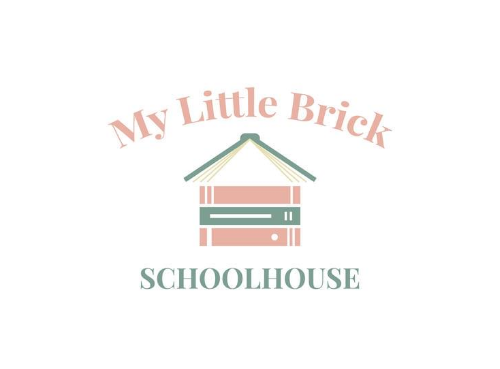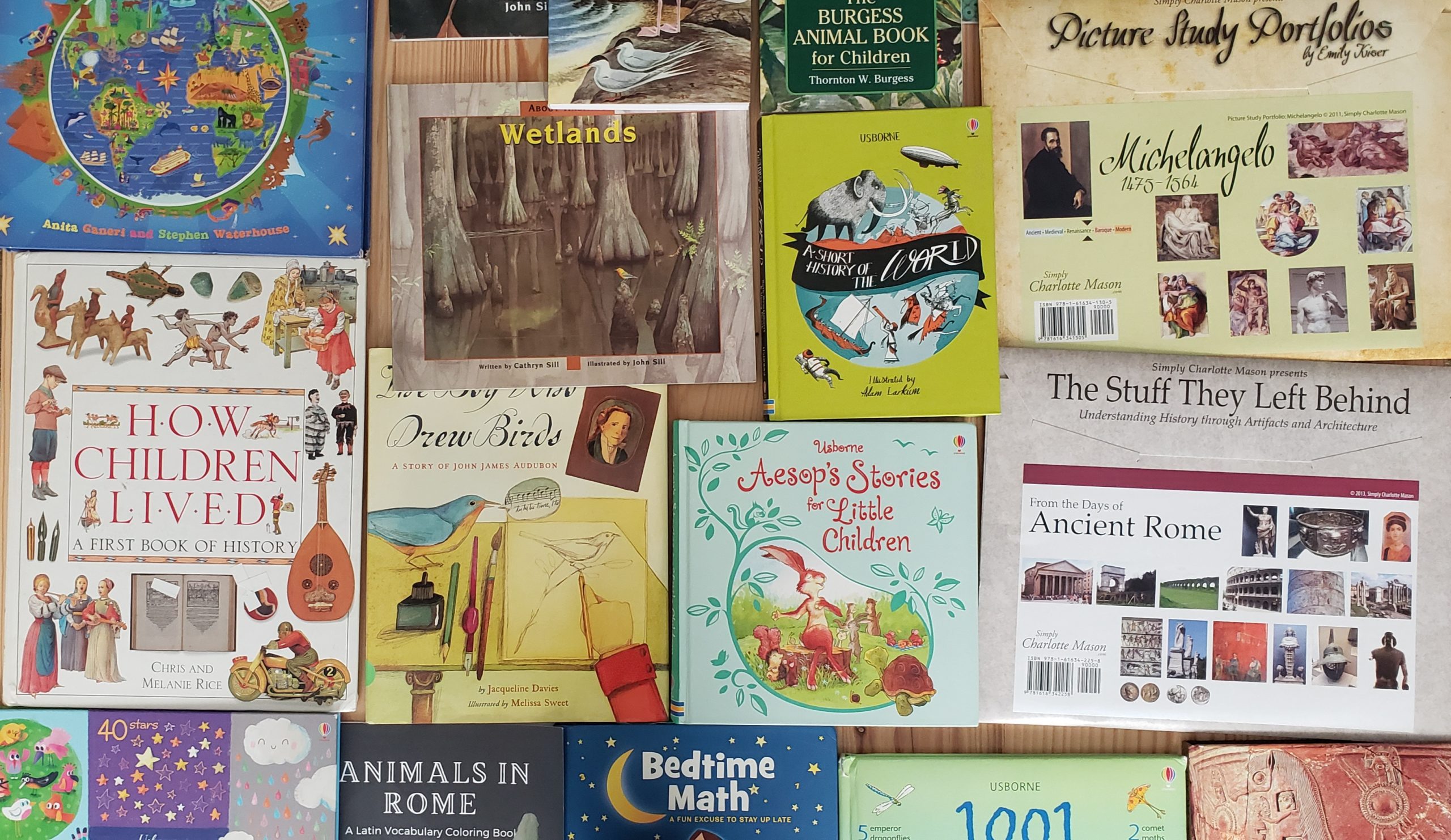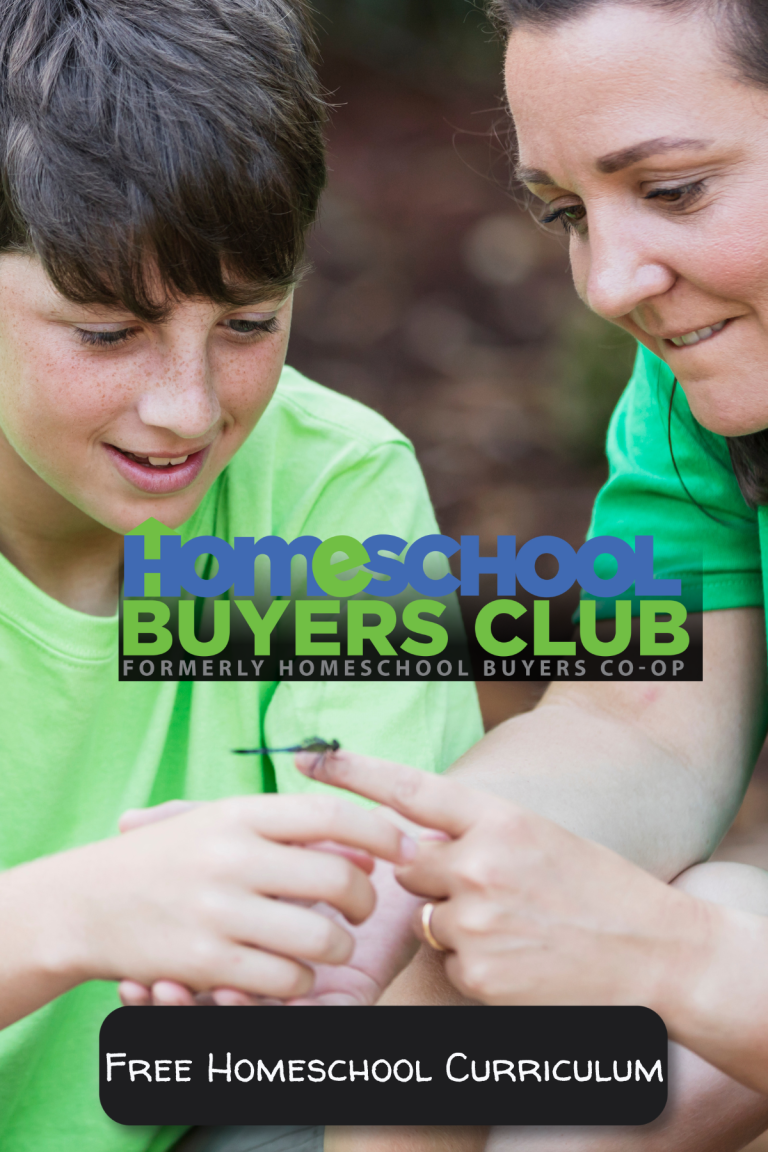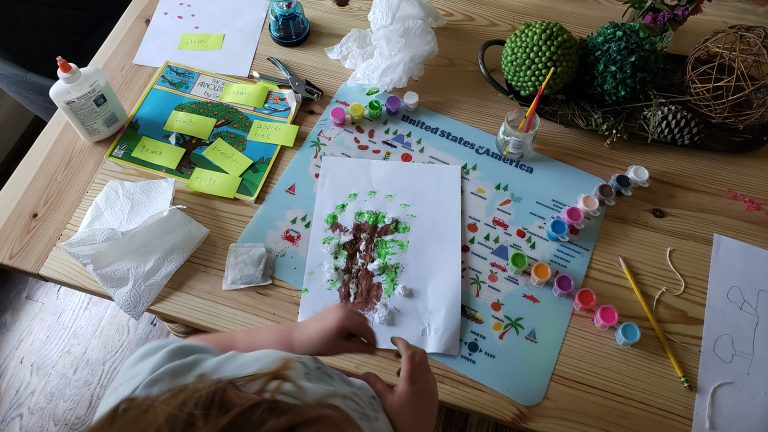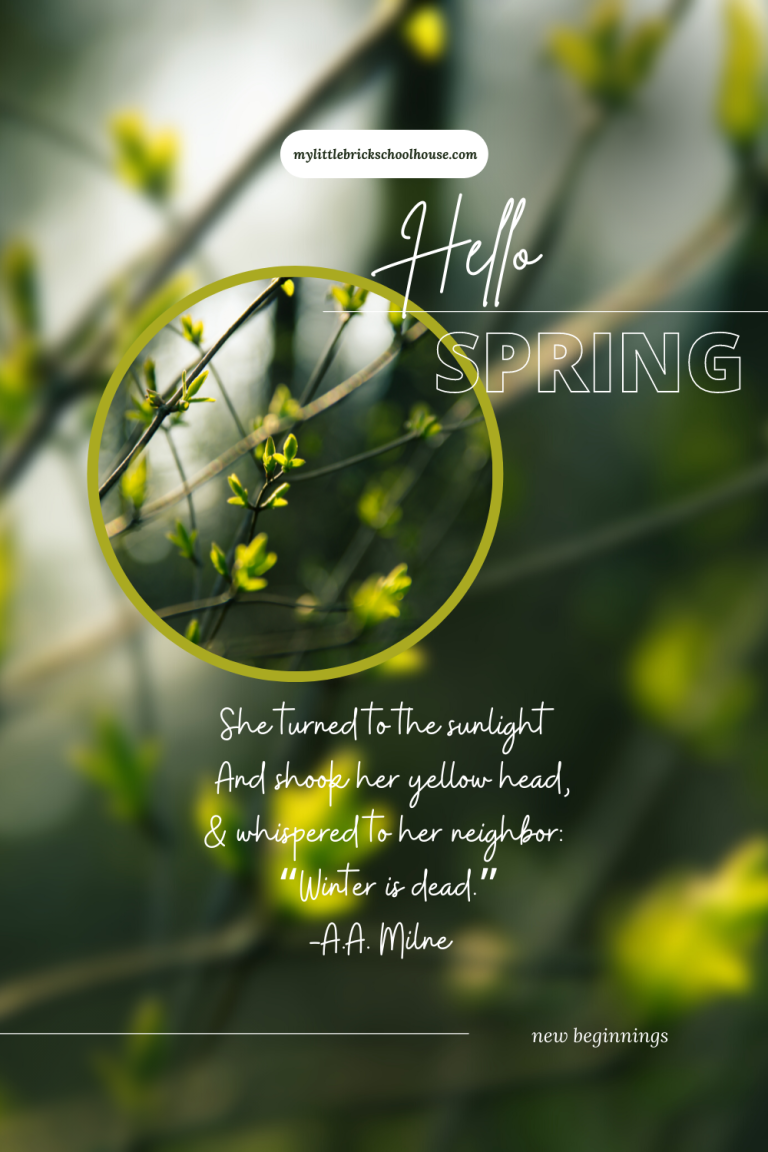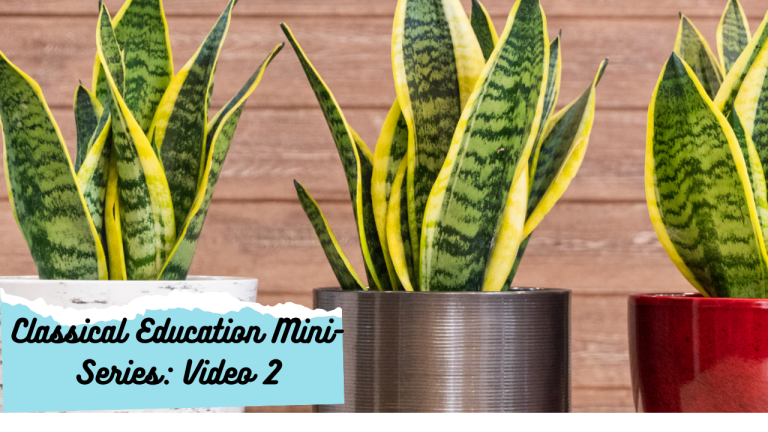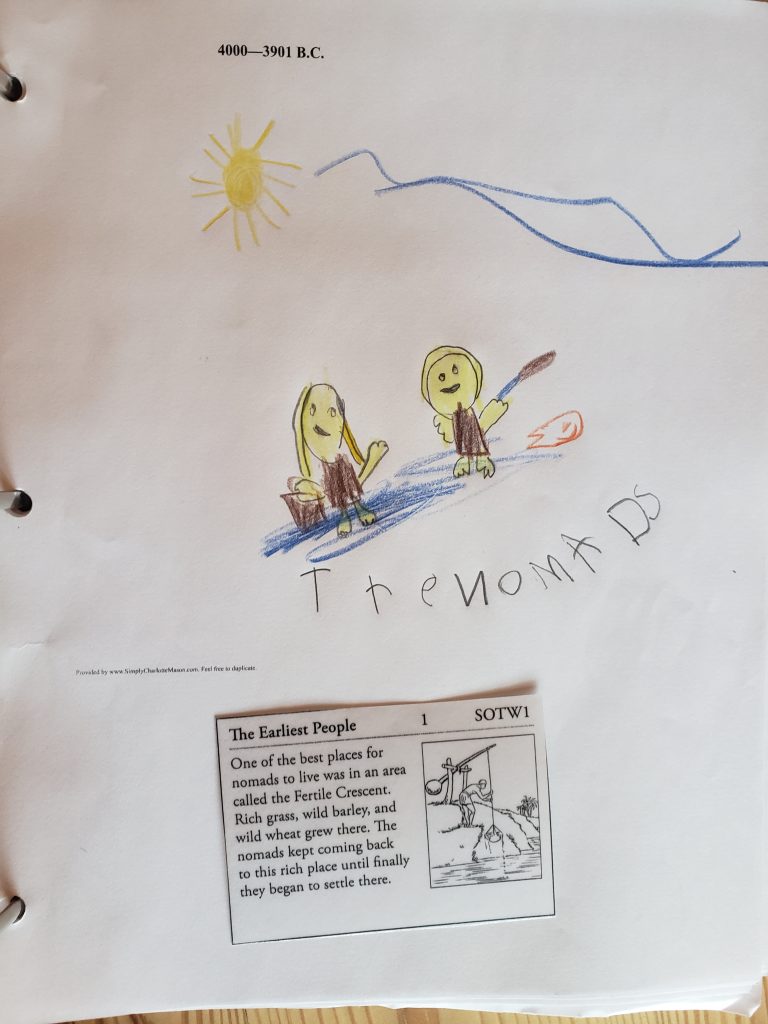A Charlotte Mason Approach to Classical Conversations, YEAR 3 of Little Brick Schoolhouse
Looking For a Booklist?
Disclaimer: If you are here to find a booklist that incorporates good, living books into a 24-week-long study of multiple content areas (aligned with Classical Conversations Foundations), you are in the right place! Scroll past the brief post, “Six Tools to Use in a Living Education”. If you are curious about Charlotte Mason methods, you might want to take about 5 minutes and read my post.

Six Tools to Use in a Living Education
- read living books
- observe
- tell it back/narrate
- record it
- memorize (this comes AFTER guided discovery)
- create something new from what you have learned
I am so grateful to have had the opportunity to learn about a living education. I have experienced bits and pieces of this, but I still strive to make it part of the basic fabric of our homeschool. More continuity, more of an atmosphere. Here I write briefly on each of these tools for a living education. My thanks goes out to Simply Charlotte Mason. The Charlotte Mason Together Retreat was unforgettable, unhurried, life-giving.
living books
One obvious way we can cultivate a living education in our homeschool is by introducing our kids to living ideas found on the pages of living books. If I had it my way, we would probably buy all of our books, but frugality matters, too. So, we use our local library. However, when a book cannot be found there (unfortunately, this is the case more often than I’d like to admit), we either borrow it from a friend or buy it. And once we have it added to our library here, we have even more opportunities to seek out the living ideas found within, spread out like a feast on the pages. Time and time again. What is a living book, you might ask? I have created a cheat sheet for you here.
observe
Picture Study. Nature Study. Composer Study. The list goes on, and in a Charlotte Mason education, we take the time to form a living, personal acquaintance with what we observe. The mere question, “What do you see? …hear?” without any interjection by the teacher can ignite the spark that allows a child to possess what he or she is beholding. To truly tell about, to put it into words, what he or she is taking in allows that child to form that living, personal acquaintance with something created by God.
Narrate/Record it
Know. Tell.
It begins with building oral fluency. It culminates with the goal of learning formal writing. Narration lays the foundation for writing well. When narration is done well, one possesses what he is beholding. This is a form of knowing, truly knowing. Therefore, narration is also a training exercise in thinking well. It’s an art. It builds relationships. If you are interested in starting this journey of narration with me, look no further than right here. I’ll keep you posted. In the meantime, take a look at the narration resource I made for those who are wanting to “test drive” narration.
memorize
Charlotte Mason taught IDEAS first, memorizing facts later. A common thread found throughout a Charlotte Mason education is “taking something into the mind’s eye”.
You can find this thread woven into the “spelling” lessons. What we call “spelling” Charlotte incorporated into the larger skill of reading and using language. Charlotte didn’t formally teach spelling as one might encounter it today in an institutionalized setting, but exercised this habit of attention to eventually have students write down a passage that was dictated to them. They would have to possess the passage in their minds’ eye, before attempting to write the dictation. This comes from memorization of words, yes, but usually within the context of a larger passage, after the students have already encountered the rich ideas found in the passage. Dictation would not be expected until around 10 years of age. Before that age, students would be practicing copy work and memorizing short phrases, pieces of a large poem or proverb.
You find this thread woven into the picture study our family has come to love.
You find this thread woven into the composer study, the nature study, the foreign language study, the list goes on.
It has taken a shift in thinking for me, to put such emphasis on the habit of attention. I will have to get used to short lessons. Only saying the directions once. I do believe it will reap benefits, not just for my kids, but also for me.
create something new
I think this is self explanatory. How could you create something new from ideas? You have surely done this before. Inspiration arises while one is living life. It usually doesn’t arise from anxiety or pressure to meet a deadline.
Let’s use my own blogging as an example. Create something new. I am starting to learn what this might be for myself. Cultivating habits that foster creativity, I hope to take incremental steps and be faithful in my writing, for example. It does not take an hour a day. It might take just 5 minutes a day. Inspiration arises from living life. So, I live my life. For me, a reliable writing routine is more about the life I live as a person, as a person who writes. I am not just a writer. So, I look for good ideas, but I am not in a frenzied state of searching. I admit, my mind does get caught up in some kind of crazy rumination at times! Nonetheless, I remember to pause and write. I remember to do something with my hands. I remember to play with my kids. I remember to go for a walk.
A Charlotte Mason Approach to Classical Conversations Cycle 1

CYCLE 1, Quarter 1(Weeks 1-6)
Subsequent quarters to come!
Disclosure: As an Amazon Associate, I may earn commissions from qualifying purchases of these CC Cycle 1 books using these links, at no additional cost to you. Thank you for your support!
Year-Round Resources
Science:
| The Story Book of Science (Yesterday’s Classics) by Jean Henri Fabre |
| Pond and Stream by Arthur Ransome |
| Pond and Stream Companion by Karen Smith |
| R.E.A.L. Science Odyssey Earth & Environment 1 by Blair Lee, M.S. |
| Backpack Explorer: On the Nature Trail: What Will You Find? by Editors of Storey Publishing |
| Look Up!: Bird-Watching in Your Own Backyard by Annette LeBlanc Cate |
| Science Encyclopedia Paperback Book w/Internet & QR Links |


Science Encyclopedia Paperback Book w/Internet & QR Links is also something we have on our shelves for quick reference or longer reading sessions.
Fine Arts:
| Website: https://artsintegration.com/2012/09/19/picture-this-exploring-art-elements-in-picture-books/ (Exploring Art Elements in Picture Books) |
| Art from Simple Shapes: Make Amazing Art from 8 Simple Geometric Shapes! Includes a Shape Stencil |
| An Introduction to Art History: A Classical Approach to Art Part II by Barry Stebbing (Ancient Art: Ancient Egypt, Ancient Greece, Ancient Rome) |
| The Stuff They Left Behind from the Days of Ancient Egypt (Simply Charlotte Mason) |
| The Stuff They Left Behind from the Days of Ancient Greece (Simply Charlotte Mason) |
| The Stuff They Left Behind from the Days of Ancient Rome (Simply Charlotte Mason) |
| Picture Study Portfolios: Michelangelo (Simply Charlotte Mason) |
| The Arts: A Visual Encyclopedia |
| Music Study with the Masters (Simply Charlotte Mason) We will be studying Bach. |
| Singing the Great Hymns (Simply Charlotte Mason) |
| Drawing With Children: A Creative Method for Adult Beginners, Too by Mona Brookes |

History:


Classical Conversations has a Bookstore that would be helpful in finding comprehensive history resources. We are currently in the FOUNDATIONS Program. History cards, Trivium Table (for Cycle 1), Cycle 1 Audio CD for reciting memory work and timeline, History cards for Artists and Composers, and Ancient World Echoes are some examples of good resources we have used or are going to use in the future. If you are looking to save some money, look into joining Classical Conversations Connected. The Foundations Learning Center has a FILE SHARING feature that has helped me find resources like history sentence copy work, memory work flipbooks, and more.


Geography:
| My Pop-up World Atlas |
| Elementary Geography by Charlotte Mason |
| A Child’s Geography: Explore the Holy Land Knowledge Quest |
| Eat Your Way Around the World by Jamie Aramini |
Math:
| Mathematicians Are People, Too: Stories from the Lives of Great Mathematicians by Dale Seymour Publications |
| The Math Chef: Over 60 Math Activities and Recipes for Kids |
| Snowman – Cold = Puddle: Spring Equations by Laura Purdie Salas |
| Bedtime Math: A Fun Excuse to Stay Up Late (Bedtime Math Series) by Laura Overdeck |
| The Lion’s Share by Matthew McElligott |
| The Doorbell Rang by Pat Hutchins |
| The Greedy Triangle (Scholastic Bookshelf) by Marilyn Burns |
Sites that promote mathematical thinking
Charlotte Mason Poetry (Math Resources)

Free Number of the Day Worksheets
| Embracing Screen-Free Life: When Grandma Gives You a Lemon Tree by Jamie L.B. Deenihan |




Week 1
Science (Classification):





Fine Arts (5 Elements of Shape):
| When a Line Bends . . . A Shape Begins by Rhonda Gowler Green |
| The Greedy Triangle (Scholastic Bookshelf) by Marilyn Burns |
| If You Were a Polygon (Math Fun) by Marice Aboff & Sarah Dillard |
| My Heart Is Like a Zoo Board Book by Michael Hall |
History (Commandments 1-5):
| Exodus from Egypt (Bible Stories) by Mary Auld |
| The Jesus Storybook Bible: Every Story Whispers His Name by Sally Lloyd Jones (10 Ways To Be Perfect chapter) |
| Old Testament Days: An Activity Guide (Hands-On History) by Nancy Sanders |
Geography (Fertile Crescent):
Math (1s and 2s):
Since I do not have any specific read aloud books for this topic of 1s and 2s, I think it might be a good idea to share how we will try to incorporate Math into our Morning Time this upcoming school year. I have a 7 and 4.5 -year-old who will be joining me, and our 2.5-year-old will be around.
introducing the math loop
Note: A loop schedule allows you to complete any activity on any particular day, just picking up where you left off the next day you get to the list. Once all the activities on the list have been “run through”, you repeat the loop from the top.
| Day | Activity (roughly 10 minutes) |
| 1 | Counting exercise on the hundreds chart |
| 2 | Number of the day from Kindergarten Mom (trace, count, frame, draw, tally, write) |
| 3 | Word Problem from Bedtime Math: A Fun Excuse to Stay Up Late (Bedtime Math Series) |
| 4 | Practice telling time on analog clock like DHCHAPU Student Learning Clock Time Teacher Gear Clock 4 Inch 12/24 Hour |
| 5 | Charlotte Mason Math Tables |
| 6 | Marcy Cook Math Game – Turn Over Tiles to Find X or Bearly Balanced Tiles |

week 2
Science (Kingdoms):
| A Mammal is an Animal by Lizzie Rockwell |
| About Fish: A Guide for Children (About…, 6) by Cathryn Sill |
| About Amphibians: A Guide for Children (About…, 5) by Cathryn Sill |
| The Burgess Animal Book for Children (Dover Children’s Classics) by Thornton Burgess |
| The Burgess Bird Book for Children by Thornton Burgess |

Fine Arts (Mirror Images):

History (Commandments 6-10):
| Exodus from Egypt (Bible Stories) by Mary Auld |
| The Jesus Storybook Bible: Every Story Whispers His Name by Sally Lloyd Jones (10 Ways To Be Perfect chapter) |
| Old Testament Days: An Activity Guide (Hands-On History) by Nancy Sanders |
Geography (Assyrian Empire):
| Map Trek The Complete Collection (I would only get Map Trek VI: Ancient World) |
| Gilgamesh the King (The Gilgamesh Trilogy) by Ludmila Zeman |
Math (3s and 4s):
See the above Math Loop resources from Week 1 Math.
Week 3
Science (Animal Cell):
| All in a Drop: How Antony van Leeuwenhoek Discovered an Invisible World by Lori Alexander |
| Cell Biology Diagram |
| Newton’s Workshop Bug Safari / Cell – A – Bration DVD by Moody Video (January 01,2010) (TRACK #6) |
| Minn of the Mississippi by Holling C. Holling (one of our very favorites) |
Fine Arts (Upside-Down):
| Optical Illusions In Art: Or–Discover How Paintings Aren’t Always What They Seem to Be by Alexander Sturgis |
| Imagine a Day by Sarah L. Thomson |
History (Greek and Roman gods):
| D’Aulaires’ Book of Greek Myths by Ingri d’Aulaire and Edgar Parin d’Aulaire |
| The Illustrated Book of Myths : Tales and Legends of the World by Neil Philip |
| Roman Myths by Geraldine McCaughrean |
| Classic Myths to Read Aloud: The Great Stories of Greek and Roman Mythology, Specially Arranged for Children Five and Up by an Educational Expert by William F. Russell |
Geography (Hebrew Empire):
| The Phoenicians: Mysterious Sea People (Ancient Civilizations) by Katherine E. Reece |
| Ten Best Jewish Children’s Stories by Daniel Sperber |
Math (5s and 6s):
See the above Math Loop resources from Week 1 Math.

week 4
Science (Plant Cell):
| Living Sunlight: How Plants Bring The Earth To Life by Molly Bang |
| Cell Biology Diagram |
| The World of Plants (God’s Design) by Debbie and Richard Lawrence |
| Newton’s Workshop Bug Safari / Cell – A – Bration DVD by Moody Video (January 01,2010) (Track #6) |

Fine Arts (Abstract Art):
| Touch the Art: Catch Picasso’s Rooster by Julie Appel |
| Touch the Art: Make Van Gogh’s Bed by Julie Appel |
| The Noisy Paint Box: The Colors and Sounds of Kandinsky’s Abstract Art by Barb Rosenstock |
| Vincent Can’t Sleep: Van Gogh Paints the Night Sky (KNOPF BOOKS FOR) by Barb Rosenstock |
History (7 Wonders):
| How the Seven Wonders of the Ancient World Were Built by Ludmila Henkova |
| The Seven Ancient Wonders of the World: A Pop-Up by Celia King |
Geography (Hittite Empire):
| The Archaeology Book (Wonders of Creation) by David Down |
| How Many Donkeys?: An Arabic Counting Tale by Margaret Read McDonald |
Math (7s and 8s):
See the above Math Loop resources from Week 1 Math.
week 5
Science (Invertebrates):
| The Bug Safari and The Cell-A-Bration DVD (Track #5: Entymology) |
| 1001 Bugs To Spot (Usborne 1001 Things to Spot) by Emma Helbrough |
| Where Butterflies Grow (Picture Puffin Books) by Joanne Ryder |
| The Big Book of Bugs (The Big Book Series) by Yuval Zommer |
| Seashells: More Than a Home by Melissa Stewart |
Fine Arts (Perspective):
History (Romans):
| City: A Story of Roman Planning and Construction by David Macaulay |
| Rome Antics by David Macaulay |
| Galen and the Gateway to Medicine (Living History Library) by Jeanne Bendick |
| Detectives in Togas by Henry Winterfield |
| Danger in Ancient Rome (Ranger in Time 2) (2) by Kate Messner |
| The Story of the Romans (Yesterday’s Classics) by H.A. Guerber |
| Animals in Rome: A Latin Vocabulary Coloring Book and Primer Titvs Classics |
Geography (Egyptian Empire):
| Mummies Made in Egypt (Reading Rainbow Books) by Aliki |
| Of Numbers and Stars by D. Anne Love |
| The Egyptian Cinderella by Shirley Climo |
| Tutankhamen’s Gift by Robert Sabuda |
Math (9s and 10s):
See the above Math Loop resources from Week 1 Math.
Week 6
Science (Vertebrates):
| The Snake Scientist (Scientists in the Field Series) by Sy Montgomery |
| Match a Track: Match 25 Animals to Their Paw Prints (Magma for Laurence King) GAME! |
| Every Autumn Comes the Bear by Jim Arnosky |
| Box Turtle at Long Pond by William George |
| Bones: Skeletons and How They Work by Steve Jenkins |

Fine Arts (Final Project):
Take a look at the Picture Study Portfolios from Simply Charlotte Mason. Choose one portfolio to focus on for the next term. Revisit the fine arts principles of shape, mirror images, upside-down, abstract art, and perspective as you study these full-color works (8.5″ x 11″ prints) by an original artist of your choice! Picture study is simple. Each portfolio includes a 5-step process to explain how picture study is conducted. Portfolios also include an artist biography, leading thoughts, Charlotte Mason inspiration regarding picture study, and specs on each masterpiece.
For first quarter, our homeschool will by doing its picture/history study on Ancient Egypt and for second quarter, Ancient Rome. Since these are not conventional artist picture studies, we will follow them with a true, artist picture study third quarter.
We will be doing our picture study in the third quarter on Michelangelo.
History (Ancient Greeks):

| A Child’s Introduction to Greek Mythology: The Stories of the Gods, Goddesses, Heroes, Monsters, and Other Mythical Creatures (A Child’s Introduction Series) by Heather Alexander |
| Bright-Eyed Athena: Stories from Ancient Greece by Richard Woff |
| How Would You Survive As an Ancient Greek? by Fiona MacDonald |
| What’s Your Angle, Pythagoras? (Charlesbridge Math Adventures) by Julie Ellis |
| The Librarian Who Measured the Earth by Kathryn Lasky |
| The Story of the Greeks (Yesterday’s Classics) by H.A. Guerber |
Geography (Ancient Greece):
| Our Little Athenian Cousin of Long Ago (Yesterday’s Classics) by Julia Darrow Cowles |
| Our Little Spartan Cousin of Long Ago (Yesterday’s Classics) by Julia Darrow Cowles |
| The Aesop for Children (classic fairy tales for children): illustrated with MP3 Downloads (Dover Read and Listen) by Milo Winter |
| Geography Matters in Ancient Greece (Geography Matters in Ancient Civilizations) by Melanie Waldron |
Math (11s and 12s)
See the above Math Loop resources from Week 1 Math.
“Education is an atmosphere, a discipline, a life.”
Charlotte Mason
